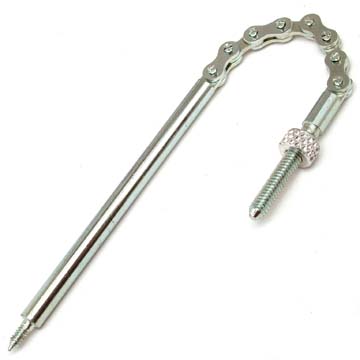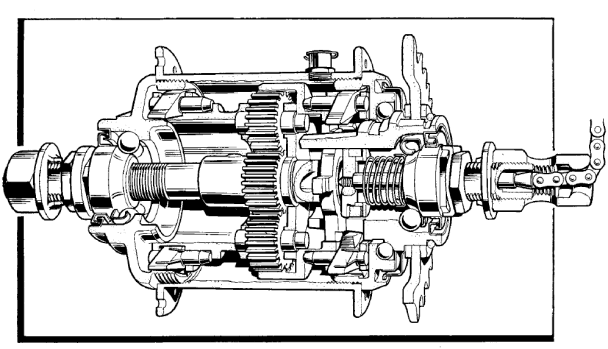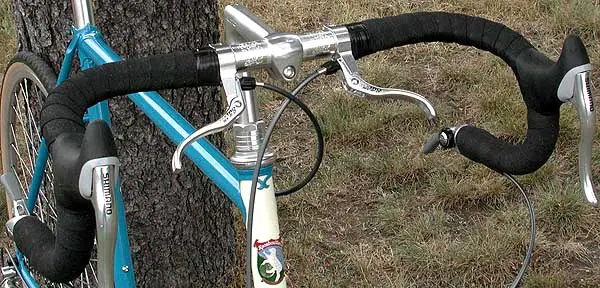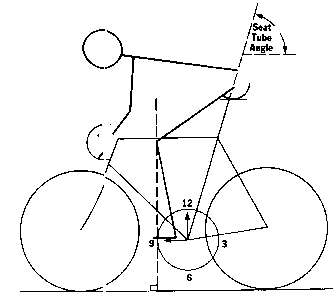Sheldon Brown's Bicycle Glossary I (original) (raw)
Opinions and value judgments are our own, unless otherwise noted
-- Sheldon (d. 2008), Harriet, John.
Additions and corrections are most welcome.
A - B - C - D - EF - G - H - IJKL - M - NO - PQ - R - S - T - UVWXYZ
Up to previous page

Idler
An idler is a pulley or roller that does not produce any mechanical advantage, nor transmit power to a shaft. Idlers are used to lead a chain around a bend (as in short wheelbase recumbents), or to take up slack in a drive chain (as in a tandem chain tensioner, or the pulleys in a derailer
IG ®
Interactive Glide is an extension of Hyperglide, in which both sides of the sprockets are contoured to improve upshifting.
I.G. sprockets are very slightly thicker than Hyperglide ones, and some Shimano Hyperglide chains may hang up if used on an I.G. cassette. The slightly wider I.G. chains work on either type, as do SRAM chains. I.G was available only with 7-speed cassettes.
Indexed Shifting
Indexed shifting means that the shift control has positive detents or click stops that provide discrete positions corresponding to different gears. See friction shifting.
If your bike has old fashioned friction shifters, consider upgrading to a modern indexed system. This is a major, very worthwhile upgrade.
Internal-gear hubs have had index shifting throughout their history.
Parts must be matched for index shifting to work correctly: the shift control must match the derailer and cassette sprocket spacing, or the internal hub. Use of mismatched or misadjusted components can put your bicycle in a "between gears" condition.
 Indicator Spindle, Indicator Rod
Indicator Spindle, Indicator Rod
Sturmey-Archer term for the small chain and shaft which fit into the axle and connect the shift cable to the internal parts of many internal geared hubs.
Sturmey-Archer indicator spindles are of a number of different lengths, to fit different hubs. Also see our article about them.
Internal
Internal gearing:
Gear systems in which the gear shifting mechanism is built into the hub of the rear wheel. This is usually accomplished by the use of planetary gears.
The most widely known form of internal gearing is in the three-speed utility bicycle. 4-and 5-speed hubs have also been available for many years, but went out of fashion during the early '70's bike boom. Shimano, SRAM (formerly Sachs) and Sturmey-Archer have revived them, and also marketed 7- and 8-speed hubs, Shimano an 11-speed as well. SRAM also offered a 9-speed model but as of 2017 has abandoned the internal-gear hub market. Rohloff offers a 14 speed model. Fallbrook Technology's NuVinci hub is continuously variable, essentially offering an infinite number of "gears."
Internal gearing is usually heavier and more expensive than derailer gearing. Bicycles with internal gearing usually have fewer speeds than comparable bicycles with derailer gears, and the mechanical efficiency is sometimes less with internal gearing.
Internal gears are generally more reliable than derailer gears, especially for bicycles which are used in wet or dirty conditions, because the gear mechanism is all contained within the rear hub, out of harm's way. The other great advantage of internal gears is that they can be shifted even when the bicycle is at a stop. This feature makes them particularly suitable for use in stop-and-go city traffic.
Not all internal gears are built into the rear hub, there are also models that are built into the bottom bracket.
Internal gears may also be combined with derailers to produce "hybrid" gearing. This system is particularly useful for bikes with smaller-than-usual drive wheels, such as folding bikes and some recumbents , as it provides a way to get adequate high gears without requiring unusually large chainwheels .
 Classic Sturmey-Archer AW 3-speed Internal Gear Hub
Classic Sturmey-Archer AW 3-speed Internal Gear Hub
Internal cable routing:
The practice of running gear or brake cables through the inside of a frame, instead of outside. This is usually done for the sake of making the bike look nicer. Unfortunately, internal cable routing usually degrades performance by increasing weight and cable friction. It can also make servicing the bicycle more difficult.


Interrupter Brake Levers
Secondary brake levers that "interrupt" the cable housings used with "æro" brake levers on drop handlebars. These allow the rider to brake while holding on to the top/middle section of the drop handlebar.
Instead of pulling on the inner cable, interrupter levers activate the brakes by pushing on the cable housing.
These are an updated version of the extension levers popular in the late '70s, without the drawbacks of the older designs.
This style of brake lever was first popularized by cyclocross riders, with the result that they're sometimes known as "cross levers" or "cyclocross levers" but there is actually nothing about them that makes them more suitable for cyclocross bikes than for any other drop bar application.

Inverted tread
An "inverted tread" is like the tread of most car tires, where the tread area may be visualized as a solid mass of rubber with grooves cut into it. "Knobby" tread, on the other hand, might be seen as a tire with thin rubber over the casing, but with knobs stuck on here and there.
Since tires are made by molding, not by cutting or sticking tread features on, this distinction is somewhat theoretical, and some tires have characteristics of both types.
"Inverted" tread tires typically have a more continuous contact area with the riding surface, so they give a smoother ride on pavement than knobby treads do. They can also give a better grip on loose, uneven surfaces than smooth tires do. They are mainly used as a compromise on- off-road tire. They don't grip as well in sand and mud as serious knobbies, and they are heavier and have more rolling resistance than smooth tires intended for paved surfaces.
Investment casting
Investment casting or "lost wax" casting permits casting of complicated shapes by using single-use plaster moulds that can be broken apart to free the cast part from the mould. This is an expensive process used mainly for high quality lugs and fork crowns.
This process is explained in detail at: http://juxtamorph.com/the-lost-wax-casting-process/


ISIS (International Spline Interface Standard)
When Shimano introduced its proprietary Octalink splined bottom bracket system, a group of other manufacturers got together to produce their own competitive splined system. This became ISIS. ISIS cranks and bottom brackets only work with each other, as do other splined systems.

ISIS Overdrive
ISIS Overdrive is an oversized standard for bottom bracket mounting to the bicycle frame. It uses a larger diameter thread, 48 mm instead of the ISO standard 1.37" (just under 35 mm.) Shell width can be either 68 or 100 mm.
The use of the ISIS Overdrive mounting dimension does not specifically require the use of ISIS splined cranks, but that is the usual configuration.
Italian
Italian bicycles are built to specific standards of threading and dimensions. Most parts on Italian-dimensioned bicycles are interchangeable with British/ISO dimensioned parts.
The major exception is the bottom bracket. Italian bottom brackets are 70 mm wide, as opposed to the usual 68 mm dimension of British/ISO and French bottom brackets. The cup diameter is also larger. Sometimes, bicycles which have damaged bottom-bracket threads are machined out to Italian size to eliminate the damaged threads. Italian bottom brackets, like the French, use a right-hand thread on both sides, so the fixed cup is prone to loosening up unless very securely tightened or secured with threadlock compound.
Italian threading is a curious mixture of metric and British. Diameters are specified in millimeters, but threads are in threads-per-inch! In addition, the thread angle is 55 degrees, as with the obsolete British Whitworth system, rather than 60 degrees as with U.S. and metric threads.
Italian freewheel and headset threads are the same as British/ISO, except for the thread angle difference. They may be interchanged, but you should not go back-and-forth between Italian and British/ISO headsets. Italian freewheels are basically extinct, so the issue is moot there. Italian-size handlebars/stems generally use a clamping diameter of 26 mm. Many high-end aftermarket drop handlebars and "road" stems also use this size even if not Italian-made.
ISM
Inter Spoke Milling ® A Mavic buzzword for rims that have been lightened by milling material from the inner circumference in the area between spoke holes. The idea is to save weight, without weakening the nipple support area. This approach results in a rim which is very un-aerodynamic.
ISO
The International Organization for Standardization. This is an international agency that is active in trying to rationalize bicycle design to make parts interchange more easily among bicycles made in different countries. Most ISO standards are compatible with British standards. These standards include:
- 1" x 24 tpi headset thread
- 1" (25.4 mm) handlebar/stem clamp diameter
- 1.375" x 24 tpi bottom bracket thread (left-hand on the fixed cup)
- 1.375" x 24 tpi freewheel thread
- 56 TPI spoke thread
- 1 mm axle thread In the case of tires and rims, the ISO adopted the E.T.R.T.O. system, the modern system for designating tire and rim sizes, based on Bead Seat Diameter. This is explained in detail in my article on Tire Sizing.
Since the standards were adopted, innovation and product differentiation have resulted in a proliferation of parts that no longer conform to them, because these parts are designed entirely differently. This has occurred with spokes, headsets, bottom brackets, chains, sprockets...


Jam Nut
A thin lock nut.
Japanese Industrial Standard (J.I.S.)
Less-expensive Japanese bicycles use J.I.S. sized headsets, better ones use Campagnolo-sized headsets. Frames and forks built for J.I.S. headsets can be machined to fit standard Campagnolo-type headsets.
J.I.S. fork crown seats are 27 mm in diameter, instead of 26.4 mm
J.I.S. head tube inside diameter is 30 mm, instead of 30.2mm
J.I.S. square-taper bottom-bracket axles use a marking system which is consistent across numerous brands.
Jockey pulley
The upper pulley on a rear derailer. This is the pulley that actually guides the chain from one sprocket to another. Shimano jockey pulleys are designed with a "Centeron®" mechanism that allows a small amount of sidewards motion to compensate for imprecise index adjustment.
J.R.A.
Industry slang for "Just Riding Along." Refers to disingenuous customers making questionable warranty claims, as in "I was just riding along when suddenly my fork bent backwards."
Jumper
African-American term for "derailer".
Junior Back
See "Kidback."
K-7
One of my favorite French puns. The letter "K" is pronounced "kah", the number "7" is "sept" (the "p" is silent, like the "p" in swimming.) Thus, "K-7" is "kah-sept" or "cassette." I first encountered this in a French electronics catalogue, and it took me quite a while to figure it out. As far as I know, the French only use this abbreviation for tape cassettes, but I have fallen into the habit of using it as a shorthand for Freehub cassettes.
Keel tube
The large tube at the bottom of a tandem frame that runs between the two bottom brackets. Also known as "boom tube."
Keirin Racing
A popular Japanese form of track racing. Keirin races are partially paced by motorcycles. This is one of the few human athletic events at which pari-mutuel betting is legal.
The governing body of Keirin racing is N.J.S. (Nihon Jitensha Shinkokai-the Japanese Bicycling Association.)
For more details, see the Wikipedia entry for Keirin.
Kevlar ®
A very strong artificial fiber, used in bullet-proof vests and bicycle tires. Kevlar is used in tires two different ways, for two different purposes:
- Kevlar beads are used on some high performance tires. Replacing the normal wire bead with Kevlar saves about 50 grams per tire. Kevlar-bead tires have the additional advantage of being foldable, making them popular as emergency spare tires with touring cyclists. Kevlar-bead tires are somewhat harder to mount on a rim, and are more likely to blow off than wire-bead tires. They work best on "hook edge" rims.
- Kevlar-belted tires have a layer of Kevlar under the tread surface, with the purpose of making the tire more resistant to punctures caused by small. sharp objects, such as thorns and glass slivers. Kevlar-belted tires have slightly higher rolling resistance, price and weight than corresponding tires without the belt.
Key
In British usage, "key" is often used as a synonym for what an American would call a wrench. Even in the U.S., the term "Allen key" is sometimes used for an Allen wrench
"Key spoke" is a term I coined to designate the first spoke installed when building a new wheel.
Keyed Washer
A keyed washer is a washer with a special-shaped hole that fits over a special shaft. It can slide, but not turn. The usual set up is to have a groove in the axle or shaft. A washer's hole will have a small tang that fits into the groove. This is almost always used in headset and pedal bearings. It used to be common in hub bearings as well, but has fallen out of favor for that application.
Another type of keyed washer fits a shaft that is round but has one (or more) flat side(s). French forks usually use this system, with a simple filed flat on the back of the steerer.
Kick-back hub
A two-speed hub, usually with a coaster brake, which switches between its two gears each time the pedals are rotated backward. This system is doesn't require any hand controls or cables. Kick-back hubs were formerly made by Bendix and Sachs, and were popular on folding bicycles and inexpensive tandems, and are currently in production by Sturmey-Archer.
Bendix (U.S. company) made 3 models, distinguished by colored stripes running around middle of the hub shell.
- The "blue band" model offered direct drive plus a higher gear.
- The "yellow band" and "red band" flavors offered direct drive plus a lower gear. The difference between the yellow and red models is in the brake. The red band had a disc-type brake, like the old New Departure coaster brakes, while the yellow band used a pair of brass shoes pressing against the inside of the shell, as with newer Bendix and other "modern" coaster brakes. Note that the sprockets are not interchangeable on these hubs: they only took a 20 tooth sprocket.
Sachs/Torpedo (West Germany) also used to make a kick-back hub. These were most commonly installed on folding/take-apart bikes, where they offer the advantage of not requiring any cables to run from the front to the rear of the bike.
The Sachs/Torpedo hub, unlike the Bendix, did allow sprocket interchangeability, using the same 3-splined sprockets used by most other multi-speed hubs (Sturmey-Archer, Shimano, SRAM/Sachs, etc.) Sprockets are available from 13-24 teeth. The Sachs/Torpedo unit is also quite a lot smaller than the Bendix models. SRAM, which purchased Sachs, introduced a kidk-bakc hub shortly before it stopped producing internal-gear hubs.
Sturmey-Archer currently (2017) makes kick-back hubs with and without a coaster brake.


Kickstand
A prop for holding a bicycle upright when it is parked. These are called kickstands because they are operated by the foot. There are several kinds:
- Clamped to the chainstays just behind the bottom bracket, and supporting the bicycle leaning to its left.
- Also leaning the bicycle to the left, but attached to a special bracket in the bottom-bracket area.
- Mounted behind the bottom bracket and with two legs either side that stow under the chain stays. This type holds the bicycle upright,
- Mounted to the left chainstay and seatstay just if front of the rear hub. This is the only type of kickstand that does not interfere with a crank. If the bicycle is rolled backwards with the kickstand down, the others can be damaged, or damage the chainstays.
Kidback
An adjustable "bottom bracket" which clamps on to the rear seat tube of a tandem to permit a child ("stokid") who cannot reach the normal stoker pedals to pedal.
Kit
A set of all the parts needed to turn a frame into a ready-to-ride bicycle. See "group."
Klingon
Wheel sucker. Term popular with tandemists, generally refers to solo cyclists who draft tandems.
Kludge
A quick and dirty, inelegant solution to a mechanical or software programming problem, cobbled together in haste or for lack of anything better that is conveniently available. Pronounced "klooje."
Knobby
A tire with an "aggressive" tread pattern, that is, one with knobs or bumps of various shapes, designed to dig into soft surfaces for better traction. Knobby tires get better traction on soft surfaces such as mud, gravel, snow, and dirt, compared with smooth treaded tires.
Knobby tires perform extremely badly on paved surfaces. The knobs greatly increase rolling resistance, and create annoying vibrations. They also corner badly on pavement, due to squirm.
Kool Stop ®
A manufacturer of brake shoes which using Mathauser technology under license from Mathauser.
K.O.P.S. (Knee Over Pedal Spindle) 
This refers to a popular fitting theory that states: When the cranks are horizontal, a plumb line straight down from the front of the rider's front knee should intersect the spindle of the pedal. This condition is achieved by adjusting the front/back position of the saddle.
This approach is quite popular with racing coaches, but it is by no means clear that this is a good setup for general cycling. Many recreational riders prefer a more rearward saddle position than this, with the extreme case being the recumbent position.
Some triathletes and time trialists prefer a more forward position. This is generally an approach that is used with æro type handlebars and arm rests.
See also Keith Bontrager's article "The Myth of K.O.P.S." and my article on Frame Sizing
KPa (KiloPascal)
A unit of pressure, equal to .01 BAR or .145 PSI.
Krate ®
Schwinn trademark for a family of wheelie bikes. These have become quite valuable to collectors.

Down to next page
A - B - C - D - EF - G - H - IJKL - M - NO - PQ - R - S - T - UVWXYZ


Articles by Sheldon Brown and Others
- What's New
- Beginners
- Bicycle Glossary
- Brakes
- Commuting
- Cyclecomputers
- Do-It-Yourself
- Essays and Fiction
- Family Cycling
- Fixed-Gear
- Frames
- Gears and Drivetrains
- Humor
- Old Bikes
- Repair Tips
- Singlespeed
- Tandems
- Touring
- Video
- Wheels
- Translations
- Sheldon - the man
Copyright © 1996, 2008 Sheldon Brown
Harris Cyclery Home Page
If you would like to make a link or bookmark to this page, the URL is:
https://www.sheldonbrown.com/gloss\_i-k.html
Last Updated: by Harriet Fell